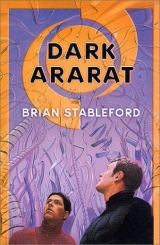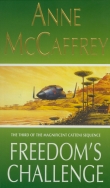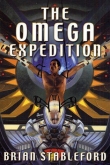
Текст книги "Dark Ararat"
Автор книги: Brian Stableford
Жанр:
Космическая фантастика
сообщить о нарушении
Текущая страница: 8 (всего у книги 27 страниц)
TWELVE
Andrei Lityansky was as tall and slim as the majority of the crew, but his skin was too dark to manifest the curious greenish tint that many of his fellows displayed. The cast of his features was slightly Semitic—a point of Earthly reference that Matthew found oddly reassuring—and his hair was jet black. He wore a neat triangular beard, the first one Matthew had seen on Hope.
Matthew had hardly had time to finish his unappetizing breakfast before Riddell had turned up to guide him to his appointed rendezvous, but Lityansky didn’t look like a man who had recently woken from refreshing sleep. He seemed a trifle fractious, like a man who did not appreciate the disturbance of his expectations by the kind of unexpected delay that Matthew had imported into his schedule. He was nursing a cup of what looked like coffee, but he didn’t offer any to Matthew.
“How is Shen Chin Che?” the crewman asked, with ostentatious irony. “We haven’t seen much of him lately.”
“As well as can be expected,” Matthew replied. “How are Captain Milyukov and the man I hit?”
“The captain’s untroubled. He had no intention of keeping any secrets from you. There was no need for you to seek out the renegades—as you must have discovered. Lamartine’s broken jaw will heal, but the other damage might be more serious.” Matthew took the second remark to imply that Lityansky had heard the tape of his conversation with Shen. The last sentence was more worrying, but he didn’t want to discuss the crew’s ambivalent attitudes to their passengers. He wanted to hear what Lityansky had to say about the ecosphere of the new world; and its underlying genomics.
Lityansky understood that, but he had his own order of priorities. He insisted on “putting the information in context,” perhaps because he thought it necessary and perhaps because he wanted to inflict a little subtle punishment on Matthew for screwing up his schedule.
“You might have heard mention of a life-bearing orphan planet that we passed close by two hundred years ago,” the biologist said. “We’ve had reports from Earth’s robot probes of two others, and of half a dozen life-bearing planets in solar systems closer to Earth than this one. That knowledge had already informed our grandfathers, long before we arrived here, that the panspermists and the more extreme convergence theorists were wrong. DNA isn’t the only basis of life to be found in the galaxy, and doesn’t appear to be common. Perhaps one coding molecule will eventually win the cosmic struggle for existence by out-competing all its rivals, but that certainly won’t happen soon—and by soonI mean any time in the next few billion years. Everything we have so far discovered suggests that we live in a galaxy in which life is very various.”
“But most of the rivals to DNA you’ve so far discovered,” Matthew put in, “aren’t capable of producing anything but bacterial sludge.”
“We don’t know that,” Lityansky said. “DNA probably couldn’t produce anything but bacterial sludge in the context of an orphan planet, and we’ve no reason to think that any of the alternative coding molecules present on such worlds would be incapable of producing complex life if they had the resources of a sunlit planet like Earth or Ararat to work with. It might, of course, be unreasonably arrogant of us to think of such worlds as the primary abodes of life or as the highest achievements of evolution. It is at least conceivable that one of the many kinds of bacterial sludge that exist in less balmy conditions will ultimately out-compete everything else, proving that metazoan creatures—including sentient humanoids—are merely temporary follies of creation.”
“Fair enough,” Matthew said. “So tell me about temporary folly number two.”
“I think you’ll find it intriguing,” Lityansky told him, teasingly. “Until we arrived here, everything we had learned from our own orphan and the data harvested from Earth’s probes suggested that there was one candidate rule of comparative evolution that seemed to have held firm. In all the other cases known to us, each ecosphere had only one fundamental reproductive molecule—DNA and RNA aren’t sufficiently different, of course, to be reckoned fundamentally different. The coding molecules were all different, but each ecosphere was derived from a single biochemical ancestor. Earth is now a partial exception to the rule—the news from home says that Earthly biotech has been enhanced by a whole new range of artificial genomic systems based on a molecule whose primary version was dubbed para-DNA—but that was the result of clever artifice. Ararat is a genuine exception: a naturalexception.
“The inference we had taken from the fact that each new ecosphere had only one fundamental coder-replicator was that in any limited arena, one reproductive molecule would be bound to win out over all others in a primordial competition—a biochemical variant of that discredited pillar of primal ecology, Gause’s axiom. That axiom can now be discounted at the biochemical level as well as the specific level. Here on Ararat there are two fundamental reproductive molecules, whose competition has been resolved in a rather peculiar way.”
“Go on,” Matthew prompted, when Lityansky paused—but he had paused for a reason, to use a keypad to summon a set of formulas and molecular models to the wallscreen behind him.
“As you can see,” he went on, “one of the molecules is a double helix that codes for proteins in a fashion roughly similar to that of DNA, although it’s a little more versatile. We call it meta-DNA, but that’s just for temporary convenience. There are too many viable molecules in what we now recognize as the DNA-para-DNA-meta-DNA family to be discriminated by the customary tags—doubtless we’ll eventually work out a whole new terminology, and maybe a whole new branch of science.
“The second molecule, here, is the oddity: a freak whose like hasn’t yet been encountered anywhere else. All the coder-replicators in the DNA family are basically two-dimensional structures, even though they’re twisted repeatedly in order to wind them up into compact structures like plasmids and chromosomes. As you can see”—here Lityansky animated the image on the screen so that the second molecular model began to rotate—“Ararat’s second coder-replicator is three-dimensional even at the most basic level of structure. We thought at first that it was tubular, like the more complicated buckyball derivatives, but those are just carbon complexes with occasional add-ons, and this has other components that are far more complex. The amplifications are mostly nitrogen, hydrogen, and oxygen, as you’d expect, and you won’t be unduly surprised by the phosphate residues—but look at the silicon and the lanthanides! You’ve never seen anything remotely like them.
“The silicon was an almost-expectable shock, I suppose, because we’ve always preset our probes to search high and low for traces of silicon or silicone-based life, both in and outside the home system. We never found any, but we kept hoping. Even running across silicone-like formations working in collaboration with rare earths as well as carbon didn’t seem so very surprising in retrospect, in view of the way that nanotech development has proceeded on Earth since we’ve been away. There’s been a dramatic convergence of the organic and the inorganic at what more recent jargon calls the picotechnological level, and the inorganic materials involved in the convergence are the descendants of the old silicon chips and modular doping arrays—but that’s artifice too. Thisis natural, although I ought to admit that there are some mavericks on the surface who aren’t entirely convinced.”
“Why not?” Matthew asked, wondering whether the “mavericks” in question included Bernal Delgado.
“Because they’re excessively impressed by the fact that this world is a billion years older than Earth. They’re not convinced that evolution happened here at a much slower rate. They wonder whether there might have been an advanced civilization here at one time: one as advanced as Earth’s. If so, they argue, it too might have developed artificial coding systems for biotechnological and nanotechnological purposes. Personally, I find it impossible to believe that any such civilization wouldn’t have left more obvious relics.”
“After a billion years?” Matthew countered.
“A sophisticated inorganic technology ought to have left someidentifiable traces,” Lityansky insisted. “There’s no evidence of any such traces on the surface. Anyhow, the situation nowis that Ararat’s second coding molecule is associated with a whole new sideline of organic chemistry, which collaborates with the one that’s a close analogue of Earthly organic chemistry. Given that fundamental collaboration, maybe it isn’t so surprising that we also find biochemical collaborations of a much more adventurous kind.
“With the aid of hindsight, perhaps it isn’t so unusual that all the metazoan cells in the Ararat ecosphere have two differently based genomes. After all, you and I and all our animal cousins have two genomes too, although the nuclear genome and the mitochondrial genome are both DNA-based. Collaboration between genomes is obviously possible, given the Earthly example, so it’s not such a huge stretch of the imagination to wonder whether it might somehow be necessary, or at least very advantageous, to the production of authentically complex organisms. It’s hard to believe that it’s mere coincidence that the only other place in the galaxy where we’ve found evidence of humanoid organisms—albeit, perhaps, unsuccessful humanoid organisms—built them on a double-genome basis.”
Matthew had been studying the molecular models carefully, hoping for some insight into their potential, but it was no more possible to deduce the organisms he’d studied with Vince Solari from the formulas on the screen than it was to deduce a housefly and a human being from the formula of DNA. It took him a few seconds to realize that the bearded man had paused again, this time in order to invite a response.
“ Collaborationwas an emotionally loaded word where I come from,” Matthew observed, cautiously. “It didn’t sit too well within the theory of evolution by natural selection. It’s not a word that Bernal Delgado was wary of using, but he wasn’t the hardest-centered Darwinian in the selection box.”
“Were you?” Lityansky asked. The way his lips had pursed when Matthew mentioned Bernal Delgado’s name told Matthew that Bernal was indeed one of the disapproved mavericks—almost certainly their loudest spokesman.
“No,” Matthew admitted, “but whenever Bernal and I got together, I was prepared to play devil’s advocate.”
“You can call it assimilation if you’d prefer that way of looking at it,” Lityansky offered, as if he were making a generous concession. “Lichens are the only obvious Earthly example of that kind of cross-category fusion, but there are a lot more here. On Ararat, the distinction between plants and animals is unclear. Lots of animals, of many different families, possess chloroplast-analogues.”
“One could argue that allEarthly plants and allEarthly animals are the products of cross-category fusions,” Matthew pointed out. “Chloroplasts and mitochondria probably started out as independent organisms that became resident in other kinds of cells.”
“However the association between nuclear and mitochrondrial DNA arose,” Lityansky said, doggedly, “it’s there and it’s productive. It produced a selective advantage that enabled organisms with it to out-compete organisms without it. Something similar must have happened here. The metazoans with two genomes won out over any metazoans that tried to get by with one, whether the one was two-dimensional or three-dimensional.”
Lityansky dismissed the various images of the new world’s coding molecules from the screen, and brought up a new set of images. At first, Matthew couldn’t make head nor tail of them, but then he realized that they were electron microscope images of cell-clusters, including some cells that were in the process of division and some clusters where neighboring cells appeared to be undergoing some kind of fusion or exchange of nuclear material.
“Can you see what’s happening here?” Lityansky asked.
Matthew couldn’t, but he wasn’t prepared to look stupid. He felt obliged to make a tentative guess.
“Reproduction,” he said. “Shuffling the genetic pack. The local equivalent of meiosis. But there’s a twist. There’s something odd about reproductive processes on this world. I never saw any young in the archive photographs, nor any obvious secondary sexual characteristics.”
It was close enough to wring a grudging flicker of respect from Lityansky. “That’s the heart of the matter,” he conceded. “I believe that biotechnologists had already begun to explore techniques of artificial chimerization by the time you left Earth?”
“Mosaic organisms had been produced by embryo fusion long before then,” Matthew said. “It was never more than a gimmick in my day, used to produce experimental interspecies hybrids and children for same-sex couples. But it’s different here, right? Chimerization is routine—and the mavericks who reckon that the genomic duplex might be a relic of ancient biotech also wonder whether the local chimeras might be echoes of a glorious past. On the other hand, patterns of chimerization must have been built into metazoan evolution when the first local slime-molds started experimenting with communal living and cellular division of labor. From there, they were handed down to the entire range of metazoans, conserved in every new burst of adaptive radiation.” His guesses were growing more elaborate now, as he picked up cues from Lityansky’s body language that told him that he was on the right track. “At any rate,” he concluded, “that’s why the big animals don’t seem to go in for sex, even though convergent evolution has made them in the same image as their Earthly counterparts in other respects. So how doesreproduction work here?”
Lityansky frowned, partly because his prepared script had been subverted and partly because he was now aware that he had underestimated his pupil. Like Milyukov, the genomicist had seen tapes of Matthew’s TV performances, and like Milyukov, he had formed an unjustly modest estimate of Matthew’s intelligence.
“As you can see,” he said, although he probably knew well enough how opaque the electron micrographs were to anyone unfamiliar with their context, “the local organisms do manifest a physiological process analogous to sexual reproduction. Individual cells do exchange genetic information—but it’s not meiosis because it doesn’t produce gametes. The exchanges are between different somatic components of chimerical mosaics.”
It took Matthew a few seconds to get his head around that. Put very crudely, what Lityansky was saying was that different bits of local organisms had sex with other bits of the same organism, which had a different genetic makeup, but that whole organisms didn’t have sex with one another. Sex on Ararat/Tyre wasn’t a matter of individuals at all; it was strictly a cell-on-cell business within chimerical individuals.
If he’d been talking to a man like Bernal Delgado, Matthew would have called it mind-boggling, but Andrei Lityansky didn’t seem to be the kind of man whose mind went in for that kind of thing.
“We’ve observed this in a wide range of primitive plants and animals,” Lityansky added, while Matthew was catching up. “We assume the same thing goes on in higher plants and animals, but that’s only speculation at present.”
“Why?” Matthew asked, genuinely surprised.
“Why what?” Lityansky retorted.
“Why is it only speculation? Why haven’t you found out?”
“The live specimens brought up into orbit had to be accommodated to the constraints of our biocontainment facilities,” Lityansky told him.
In other words, Matthew thought, Lityansky had never seen an alien creature he couldn’t fit on to a microscope slide.
“The work we’ve done on Hope,” Lityansky continued, “has consisted of fundamental biochemical, genomic, and proteonomic analyses. The biologists at Base One have had more opportunity to observe more complex organisms in the wild, but their lab work has had to be devoted almost entirely to the practical problems of adapting Earthly crops and animals to live in native environments.”
“That’s ridiculous!” Matthew said. “Are you telling me that you’ve been confronted for three yearswith a world whose higher plants and animals don’t appear to have any sex organs or to produce any young, but that you haven’t made any significant attempt to find out how they doreproduce?”
“What I’m telling you,” Lityansky said, frostily, “is that we’ve had too few people working on far too many problems to have made as much progress as we would have liked, or as much progress as we need. We had no idea, when we began, how strange the physiology of the most primitive organisms would turn out to be, but we have taken the view that if we can unravel the mysteries of the simpler entities first, we will then stand a far better chance of understanding the mysteries of the more complex.”
“So how do the simple entities reproduce themselves?” Matthew wanted to know.
“Some by simple fragmentation, others by sporulation.”
“Just like a lot of simple entities on Earth,” Matthew pointed out. “Not much help there in figuring out how the monkeys and the weasels do it. What’s the favorite hypothesis?”
“I don’t have a favorite hypothesis,” the bearded man told him. “That’s not the way I work.”
“So what’s the favorite hypothesis of the people who dohave favorite hypotheses? What was Bernal Delgado’s favorite hypothesis?”
Lityansky pursed his lips. “Professor Delgado had become fond of speculating about gradual chimerical renewal,” he admitted. He seemed reluctant to dignify the phrase with elaboration, let alone explanation, but it only took Matthew a moment to connect the term to its most celebrated referent.
“Gradual chimerical renewal is a fancy name for the Miller Effect,” he said. “That’s not reproduction. That’s a kind of emortality.”
“Gradual chimerical renewal is a general concept, one of whose specific instances is the so-called Miller Effect,” Lityansky said, using pedantry to avoid simple agreement.
“I get it,” Matthew said. “It doesn’t remove the need for an account of reproduction, but it mightexplain why rates of reproduction are so slow that it’s almost impossible to observe immature individuals.”
“It’s pure speculation,” Lityansky pointed out, “and it’s verydifficult to put any such hypothesis to the test. There’s no way to establish how long any individual is potentially capable of living if you can only observe it for a limited period of time. May I return to matters of which I dohave some reliable knowledge?”
“I’m sorry I interrupted,” Matthew said, hoping that he didn’t sound too insincere.
“We havebeen able to study the various ways in which the simpler chimeras are compounded,” Lityansky went on, “and the ways in which certain individuals seem to hybridize types that would have been considered on Earth to be different species. Earth wasn’t entirely devoid of natural chimeras, of course. Mules and zeehorses, tigons and ligers were the most obvious—all compounds of closely related species, and they were unable to reproduce themselves because they were almost invariably sterile. There were, however, others far less obvious. In species where multiple embryos were simultaneously implanted, producing litters of fraternal twins, two embryos would occasionally fuse into a single individual. If the result was a fetus in fetuit usually aborted spontaneously, but in rare instances it resulted in a mosaic individual: a single-species chimera not unlike one of those produced by artifice for same-sex couples. The phenomenon was not unknown even in humans, although very rare.
“After it became possible in the late twentieth century to identify such same-sex chimeras by DNA analysis, some studies did suggest that animals of that kind could manifest a kind of hybrid vigor, because the fact that their individual tissues included two complete sets of chromosomes instead of one made them less vulnerable to genetic deficiency diseases. That was irrelevant from the viewpoint of natural selection, because each individual sperm or egg produced by a mosaic individual could only be a product of one set of genes …”
“But if the mosaic identity had been heritable,” Matthew put in, “then Earthly mosaics might have had sufficient selective advantages over single-genome individuals to have become the norm!”
Lityansky had grown used to Matthew’s interruptions by now, and accepted this one with better grace. “Perhaps. Here, where sexual exchanges occur between the cells of chimerical individuals rather than between the whole individuals, and where primitive reproduction is a matter of fragmentation and sporulation, the fundamental situation is very different. We can only speculate as to what happened in the earliest phases of evolution on Ararat, but the situation nowis that sexual exchanges between chimerically associated genomes produce new types of somatic cells, some of which are then shed, or encapsulated as spores, which may then meet and fuse with the similar products of other individuals, eventually growing into new chimerical wholes. The vast majority of those we’ve so far catalogued are equivalent to Earthly same-species chimeras, but some are more ambitious combinations, of a kind manifest on Earth only in the lichens—”
“Hold on,” Matthew said, as he was struck by a sudden inspiration. “I’m not sure that’s true.”
“ What’s not true?” Lityansky snapped back.
“That the only ambitious chimeras on Earth are lichens. What about insects?”
Lityansky was mystified. “What about insects?” he countered.
“Well, what’s an insect but a serial chimera? The imago is only a maggot’s way of making more maggots, so they’re exactly like lichens in being strapped into a specific straitjacket by the limitations of sexual reproduction, but what an insect has, in essence, is a genome that codes for two quite different physical forms.”
“I don’t think it helps to introduce the notion of serial chimeras,” Lityansky complained. “The whole point about the situation here is that the vast majority of organisms on Ararat are made up of simultaneouschimerical combinations of cell types.”
Matthew didn’t want to be slapped down so easily. “When Solari and I were trawling through the data banks yesterday,” he said, “arthropod analogues seemed conspicuous by their absence. Assuming that the insects and their kin didn’t just slip into the cracks of our admittedly slapdash search, mightn’t that have something to do with the prevalence of un-serial chimeras?”
Lityansky wasn’t impressed. “It’s true that Ararat’s ecosphere has a dramatic dearth of exoskeletal organisms,” he admitted. “We think it’s because the local DNA-analogue has a blind spot where chitin and its structural analogues are concerned. We think that the principal reason for the apparent depletion of the vertebrate-analogues by comparison with Earth is due to the same blind spot. The local organisms aren’t good at producing hard bone. Their endoskeletons are more like cartilage, which means that the bigger animals need more complicated articulations to produce similar leverage. The organisms you saw in those photographs aren’t as similar to their Earthly analogues as they appear at first glance. Each individual might almost be regarded as a fusion of several disparate individuals, routinely combining as many as eight different genomic cell types. In some cases, only half of those cell types are sufficiently similar that they’d be reckoned as same-species in Earthly terms. We’ve hardly begun to extrapolate the possibilities opened up by that fundamental difference.”
Or to investigate it, Matthew added, silently.
“So the ultimate question—the one that dominates all our minds—is admittedly less simple than it seemed to be three years ago, but also more intriguing,” Lityansky added. His rhetorical manner suggested that his discourse was nearing some kind of climax.
Matthew knew that the question Lityansky must have in mind was whether or not it would be possible to establish a viable colony on the surface of the new world. “Go on,” he prompted.
“We had assumed, before arriving here,” Lityansky said, “that the question of whether we could introduce DNA-based ecosystems into an ecosphere that had its own distinct DNA-analogue was relatively straightforward. There was a possibility that DNA organisms might not be able to hold their own in the resultant competition, or that the local organisms might be at a disadvantage, either case presenting a conservation problem. With respect to Ararat, however, we have to ask the question of whether the second genomic system might be integrated into DNA-based organisms, to work in association with them in much the same way that it works in association with the local DNA-analogue. We also have to ask whether we can turn the chimerical constitution of the local organisms to our own technological advantage. In both cases, I believe, the answer is yes. Given what the biotechnologists of Earth have accomplished by taking over the innate natural technology of Earthly organisms, there is good reason to believe that they might accomplish just as much—if not more—by taking control of the natural technology available here, whose potential we have only just begun to glimpse.
“In brief, Professor Fleury, there is abundant potential here for a biotechnological bonanza that will have Earth’s megacorporations racing one another to establish a presence here and reap its benefits.”
Matthew could easily see how attractive that possibility might be to the crew of Hope. If the new world could attract enthusiastic support from Earth, it wouldn’t need the kind of support from Hopethat had been built into Shen Chin Che’s original plan—not, at any rate, for very long.
But there was another side to the coin.
“By the same token,” Matthew said, reflexively taking on the role of devil’s advocate, “there might also be potential here for an ecocatastrophe of an entirely new and previously unenvisaged kind—an ecocatastrophe that could devastate the colony. That’s why the people on the ground are so nervous, isn’t it? That’s why so many of them are ready to give up on the dream that brought them across fifty-eight light-years of void and seven hundred years of history.
“If the three-dimensional genome is capable of producing infectious agents, its biochemistry is so radically different that all the painstaking technological defenses we’ve built against bacteria and viruses will be useless against them. If the processes by which local organisms can produce exotic chimeras can be extended to embrace Earth-originated cells, we might encounter whole new modes of infection.
“In either case, this world could be a potential death trap!”








